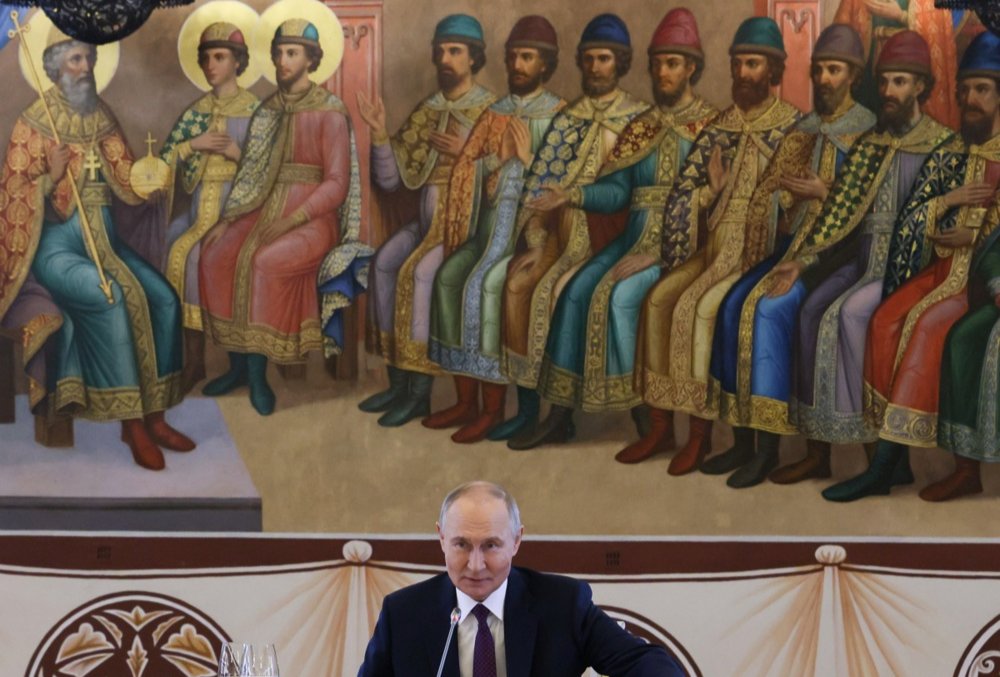




Vladimir Putin attends a working lunch meeting with Chinese President Xi Jinping in Moscow, Russia, 8 May 2025. Photo: EPA-EFE/MIKHAIL METZEL/SPUTNIK/KREMLIN/POOL
Russia’s memorandum on an end to the war in Ukraine presented at Monday’s talks in Istanbul outlined two punitive frameworks for a ceasefire and restated Moscow’s maximalist demands for territory and neutrality from Kyiv, Russian state media has reported.
The first section of the document lays out what Moscow calls the “main parameters for a final settlement” of the conflict. These include the withdrawal of Ukrainian forces from the Russian-occupied Donetsk, Luhansk, Kherson, and Zaporizhzhia regions, as well as Crimea, and their international recognition as part of Russia.
It also demands that Ukraine adopt a neutral status, refrain from joining any military alliances, and prohibit foreign troops or military infrastructure on its territory. It calls for strict limits on the size of the Ukrainian Armed Forces, official status for the Russian language in Ukraine, and a ban on the “glorification and propaganda of Nazism and neo-Nazism” as well as nationalist political parties.
The second section of the memorandum outlines two ceasefire proposals, the first of which calls for the complete withdrawal of Ukrainian forces from all Russian-occupied regions of eastern Ukraine and their relocation to an agreed distance from what Russia considers the border between the two countries.
The second ceasefire framework does not require an immediate Ukrainian withdrawal from areas occupied by Russia, but instead demands an end to Ukraine’s mobilisation and martial law, a halt to all foreign military aid and intelligence-sharing with Kyiv, and the holding of presidential and parliamentary elections within 100 days of martial law being lifted.
It also seeks restrictions on the movement of Ukrainian forces, a ban on foreign military personnel in Ukraine, and an end to what Moscow describes as Ukrainian “sabotage and subversive activities against the Russian Federation and its citizens”. Ukraine would also be required to forego any claims for reparations from Russia and release individuals Moscow deems to be “political prisoners”.
Russian delegation head Vladimir Medinsky said the demands outlined in the first section of the memorandum laid the foundation for a “truly lasting peace”, while the two ceasefire proposals detailed “the steps to be taken towards a real ceasefire”.
Many of the demands laid out by Russia in the memorandum are likely to be non-starters for Kyiv, which, according to Reuters, is seeking “no restrictions on its military strength after any peace deal, no international recognition of Russian sovereignty over parts of Ukraine taken by Moscow’s forces, and reparations” as terms for ending the war.
Ukrainian delegation head Rustem Umerov on Monday evening criticised Russia for not submitting their peace terms for discussion earlier despite US pressure to do so, saying that the move hindered progress towards a ceasefire.
“Our documents were submitted in advance. In contrast, the Russian ‘memorandum’ appeared only today — during the meeting itself. This created conditions that prevented the meeting from delivering the results needed to end the war,” Umerov wrote on Facebook on Monday evening. “It seems the Russians are once again stalling for time, trying to create a ‘diplomatic show’ for the US without taking real action”.
